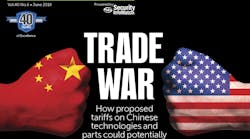There are numerous items affected by the tariffs recently levied on Chinese goods by the Trump administration we’ve covered previously that will have a significant impact on the security industry, but now all three Harmonized Tariff Schedules (HTSUS) have subheadings with electronic circuit boards and components that are sourced from China and assembled in the U.S.
The rise of connected devices, the Internet of Things (IoT), virtual reality (VR), and artificial intelligence (AI) has led to continued growth of microcomputer and storage device sub-markets. The industrial uses for products like Raspberry Pi and Adafruit’s Arduino continue to expand, especially in video processing and storage applications in smaller use cases like quick serve stores and residential properties. The price just can’t be beat; why now do we have restrictions on a growth security market?
In previous tariffs, both copper stock, commonly used in network cabling, and fiber optic bundles were targeted. In light of the increasing dependence on higher CAT 6A and 7 cables, which require more copper to fabricate, the unit installed cost of all principal security sensors would increase.
Given a fixed budget, an end-user will always build out infrastructure and then estimate additional systems for the remainder of the funds. This equals less devices and subsequently less revenue for all parts of the security ecosystem.
The impact of the third round of tariffs, which is actually a supplement to the second HTSUS and dated 8/7/2018, is as follows:
(Note: The official U.S. Trade Representative’s Office (USTR) document (USTR-2018-0005) are classified in 8-digit subheadings; thus, where possible, the Harmonized Tariff Schedule (HTS) eight digit number will be listed in parentheses for reference purposes)
High Impact
- Electronic Integrated Circuits, processors, controllers, memory, amplifiers and parts of assemblies (8542.31.00, 8542.32.00, 8542.33.00, 8542.39.00, 8542.90.00): Electronic security systems affected include video surveillance, burglar alarm and access control systems by manufacturers that assemble using PCBs from China, South Korea, Taiwan and the Philippines. The commercial, residential, “DIY” and crowdfunded markets use microcomputers and controllers sourced from China. For example, the most popular microcomputer used in the electronic security industry, the Raspberry Pi, is manufactured in China and the UK. Also used are Intel's microcomputer modules, whose processor boards are assembled and tested in Western China and Malaysia.
Medium Impact
- Antennas and antenna reflectors of all kinds and parts (8529.10.91) affects all wireless access points, wireless bridges, backhauls and point-to-point systems used to transmit video surveillance, alarm signals and object detection data.
- Connectors for optical fibers, optical fiber bundles or cables (8536.70.00): Affects virtually all fiber optic terminations, splices, patch panels and pathways. This also affects the economies of scale for sites requiring high numbers of telecommunications closets or “equipment rooms,” Intermediate Cross Connects (ICC or IC) and Main Cross Connects.
About the Author:
Steve Surfaro is Chairman of the Public Safety Working Group for the Security Industry Association (SIA) and has more than 30 years of security industry experience. He is a subject matter expert in smart cities and buildings, cybersecurity, forensic video, data science, command center design and first responder technologies. Follow him on Twitter, @stevesurf.





